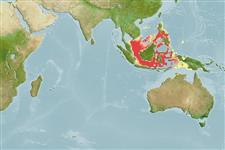Lớp phụ Cá sụn (cá mập và cá đuối) (sharks and rays) >
Carcharhiniformes (Ground sharks) >
Pentanchidae (Deepwater catsharks)
Etymology: Halaelurus: halos (Gr.), sea; ailouros (Gr.), cat, probably an allusion to the vernacular “catshark,” so named for its cat-like eyes. (See ETYFish); maculosus: Latin for speckled, referring to speckling of small dark spots over dorsal and lateral surfaces of body. (See ETYFish).
More on authors: White, Last & Stevens.
Environment: milieu / climate zone / depth range / distribution range
Sinh thái học
Biển gần đáy. Tropical
Pacific Ocean: known from the southern coast of Java, and off the islands of Bali and Lombok in eastern Indonesia, and has also been recorded from several landing sites in the Philippines (Ref. 59315).
Bộ gần gũi / Khối lượng (Trọng lượng) / Age
Maturity: Lm ? range ? - ? cm
Max length : 45.7 cm TL con đực/không giới tính; (Ref. 59315); 52.8 cm TL (female)
Short description
Hình thái học | Sinh trắc học
Small adult size; Body tapering, anterior trunk wide and somewhat depressed; tail long and slender, almost circular in cross-section at second dorsal-fin insertion; no lateral keels; no postnatal ridge between anal fin base and lower caudal-fin origin; no longitudinal ridges on dorsal surface, no obvious lateral ridges. Head short, wide and somewhat depressed, more so between eyes and ventrally; narrowly pointed, not upturned or knob-like in lateral view (slightly upturned in some paratypes); in dorsoventral view anterior to gill openings broadly parabolic; subocular ridge evident, variably angular. Eyes small, spindle-shaped; dorsolateral on head, with lower edges well medial to lateral head margin in dorsal view; subocular ridges weak, not well defined, subequal in length to eye, almost a spiracle length from eye margin; no supraorbital crest (Ref. 59315).
Reported to be caught occasionally by demersal fisheries, but no depth distribution information is available (Ref. 59315).
Life cycle and mating behavior
Chín muồi sinh dục | Sự tái sinh sản | Đẻ trứng | Các trứng | Sự sinh sản | Ấu trùng
White, W.T., P.R. Last and J.D. Stevens, 2007. Halaelurus maculosus n. sp. and H. sellus n. sp., two new species of catshark (Carcharhiniformes: Scyliorhinidae) from the Indo-West Pacific. Zootaxa 1639:1-21. (Ref. 59315)
IUCN Red List Status (Ref. 130435)
Threat to humans
Harmless
Human uses
Thêm thông tin
Age/SizeSự sinh trưởngLength-weightLength-lengthLength-frequenciesSinh trắc họcHình thái họcẤu trùngSự biến động ấu trùngBổ xungSự phong phúBRUVS
Các tài liệu tham khảoNuôi trồng thủy sảnTổng quan nuôi trồng thủy sảnCác giốngDi truyềnElectrophoresesDi sảnCác bệnhChế biếnNutrientsMass conversion
Các công cụ
Special reports
Download XML
Các nguồn internet
Estimates based on models
Preferred temperature (Ref.
123201): 22.2 - 28.4, mean 27.4 °C (based on 51 cells).
Phylogenetic diversity index (Ref.
82804): PD
50 = 0.5078 [Uniqueness, from 0.5 = low to 2.0 = high].
Bayesian length-weight: a=0.00355 (0.00176 - 0.00714), b=3.09 (2.91 - 3.27), in cm total length, based on LWR estimates for this (Sub)family-body shape (Ref.
93245).
Mức dinh dưỡng (Ref.
69278): 4.4 ±0.5 se; based on size and trophs of closest relatives
Thích nghi nhanh (Ref.
120179): thấp, thời gian nhân đôi của chủng quần tối thiểu là 4.5 - 14 năm (Preliminary low fecundity).
Fishing Vulnerability (Ref.
59153): Moderate vulnerability (41 of 100).
